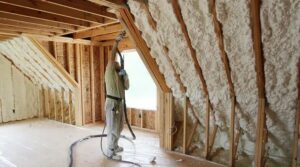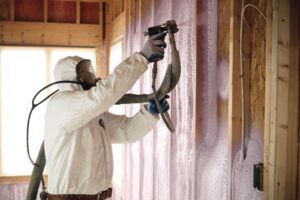High-performance insulation plays a critical role in improving energy efficiency, reducing utility costs, and enhancing indoor comfort in Wichita homes. In a region marked by intense seasonal shifts—icy winters and blistering summers—standard insulation options often fall short in providing year-round protection. Spray foam insulation, particularly open-cell and closed-cell varieties, offers a durable, high-efficiency alternative that addresses air leakage, moisture control, and thermal performance in one application.
For homes across South-Central Kansas, the benefits of selecting high-performance insulation go beyond comfort. With rising energy prices and increasingly unpredictable weather patterns, homeowners in Wichita require insulation solutions that function under extreme conditions. This guide provides field-tested insights into the most effective insulation materials, compares key specifications, and details climate-appropriate strategies. All recommendations are rooted in on-site application knowledge and material performance tracked across residential, agricultural, and commercial settings. Arma Coatings of Wichita implements these principles using precision installation methods and real-world diagnostics.
Key Differences Between Common Insulation Types
| Insulation Type | R-Value per Inch | Air Sealing | Water Resistance | Best For | Estimated Lifespan |
| Open-Cell Spray Foam | 3.5 – 3.7 | Excellent | Low | Interior walls, sound control | 60+ years |
| Closed-Cell Spray Foam | 6.0 – 7.0 | Excellent | High | Exterior walls, foundations | 80+ years |
| Fiberglass Batt | 2.9 – 3.8 | Poor | None | Standard retrofit jobs | 20 – 30 years |
| Blown-In Insulation | 2.2 – 4.0 | Moderate | Low | Attic floors | 20 – 30 years |
| Rigid Foam Board | 4.5 – 6.5 | Good | Moderate | Basements, exterior sheathing | 30 – 50 years |
Bonus Tip:
For mixed-application projects, consider combining open-cell and closed-cell foams to balance soundproofing with moisture control.
Performance Factors That Matter Most in Wichita
Wichita homes require insulation that withstands extreme heat, bitter cold, and humidity swings—all within the same year. The structural integrity of insulation under these shifting conditions is essential. Spray foam’s expansive nature helps eliminate thermal bridges and air infiltration points, two common causes of energy loss in Midwestern housing.
Technical Performance Table
| Property | Open-Cell Spray Foam | Closed-Cell Spray Foam |
| R-Value (per inch) | 3.5 – 3.7 | 6.0 – 7.0 |
| Vapor Retardant | No | Yes |
| Expansion Rate | High (100x) | Medium (30-40x) |
| Structural Reinforcement | No | Yes |
| Sound Dampening | High | Moderate |
| Cost per Sq Ft (Installed) | $1.00 – $1.50 | $1.75 – $3.00 |
Additional factors include adhesive strength, resistance to pest intrusion, and ease of installation in irregular cavities.
Bonus Tip:
When insulating attics in Wichita, use a hybrid method with closed-cell foam at the roofline and blown-in cellulose on the attic floor for layered protection.
Things to Consider Before Making a Decision
- Budget vs. Performance: Open-cell is economical for interior applications, while closed-cell offers long-term value in critical zones like foundations and roofing.
- Application Area: Identify which zones need moisture resistance versus which need acoustic control.
- Building Age: In older homes, evaluate the presence of outdated insulation types that may need full removal.
- Ventilation Needs: Integrating a mechanical ventilation system may be necessary in tightly sealed homes.
- Building Type: Pole barns and metal buildings require insulation that resists interior condensation and structural vibration.
- Local Codes and Rebates: Check current Wichita or Kansas-specific energy codes and rebates for qualified insulation upgrades.
Regional Climate Insights: Why It Matters in Wichita
Wichita experiences both high humidity in summer and low dew points in winter, leading to condensation risks in uninsulated cavities. Choosing the wrong insulation leads to mold formation, drafty interiors, and inconsistent energy bills. Closed-cell foam’s impermeability is ideal for below-grade walls and roof decks, while open-cell foam is better suited to expanding into wall cavities and providing sound insulation.
Spray foam also helps maintain consistent humidity levels indoors, which protects hardwood floors, drywall, and structural framing. Data from the U.S. Department of Energy (DOE) shows that homes with properly sealed and insulated envelopes can reduce heating and cooling costs by up to 35% in mixed-humid climates.
Bonus Tip:
Apply closed-cell spray foam to underside roof decks in ventless attics. This enhances envelope performance and protects against ice damming in winter.
Common Questions People Ask First
- What’s the most cost-effective insulation for Wichita homes?
- Open-cell foam offers mid-range R-values at a lower price, ideal for interior retrofits.
- Open-cell foam offers mid-range R-values at a lower price, ideal for interior retrofits.
- Is spray foam safe for homes with kids or allergies?
- Yes. Once cured, spray foam does not release VOCs, and it resists mold and allergens.
- Yes. Once cured, spray foam does not release VOCs, and it resists mold and allergens.
- Can insulation be installed in winter?
- Yes. Spray foam can be applied in winter using heated rigs and appropriate substrate temperatures.
- Yes. Spray foam can be applied in winter using heated rigs and appropriate substrate temperatures.
- How much insulation is enough for Wichita?
- Use DOE-recommended R-values: R-49+ in attics, R-21+ in walls. Closed-cell helps meet targets with less space.
- Use DOE-recommended R-values: R-49+ in attics, R-21+ in walls. Closed-cell helps meet targets with less space.
- Will insulation help with soundproofing?
- Yes. Open-cell foam is effective at dampening airborne sound transmission in interior walls and ceilings.
- Yes. Open-cell foam is effective at dampening airborne sound transmission in interior walls and ceilings.
Services Backed by Building Science and On-Site Experience
Open-Cell Foam Insulation – Low-density insulation that fills cavities entirely. Ideal for sound attenuation and interior comfort.
Closed-Cell Foam Insulation – High-density foam that strengthens structure, resists moisture, and delivers unmatched R-values.
Metal Building Insulation – Spray foam designed to adhere to metal substrates and prevent interior sweating.
Pole Barn Spray Foam – Moisture-resistant insulation applied directly to framing for agricultural structures.
Residential Foam Insulation – Customized solutions for Wichita homes ranging from retrofits to new builds.
New Construction Spray Foam – Insulation applied during framing to create a seamless thermal and air envelope.
Commercial Foam Insulation – High-performance materials used for compliance with commercial energy codes.
Spray Foam Air Barriers – Used in conjunction with other air control layers to achieve near-zero air leakage.
Duct Spray Insulation – Reduces HVAC losses by sealing air ducts in attics and unconditioned spaces.
Metal Roof Restoration – Closed-cell foam topped with elastomeric coatings for reflective and weatherproof finish.
Roof Restoration – Used on flat and low-slope roofs to increase thermal performance and seal aging membranes.
Agricultural Spray Foam Insulation – Designed for animal housing and equipment barns needing stable temperature control.
CMU Blocks Filling – Closed-cell foam injection into concrete masonry units to enhance R-value and block air infiltration.
FAQ Section
How long does spray foam insulation last?
When installed properly, spray foam can last more than 80 years without sagging or settling.
Can insulation be removed or replaced later?
Yes, though difficult. Removal often requires mechanical scraping or saw-cutting. Plan for long-term performance at installation.
How does insulation impact indoor air quality?
It reduces infiltration of allergens, dust, and pollutants. Air exchangers may be necessary in tightly sealed homes.
Do I need a vapor barrier with spray foam?
Closed-cell spray foam includes built-in vapor resistance. Open-cell may require additional vapor control layers in humid zones.
What’s the difference between fiberglass and spray foam?
Spray foam insulates and air seals in one step. Fiberglass only insulates and allows air movement if not perfectly installed.
Ready to Achieve Energy Efficiency and Indoor Comfort?
Apply these insights now: Schedule your custom insulation assessment with Arma Coatings of Wichita to take full advantage of modern insulation technology. Achieve comfort, energy savings, and long-term protection.
Contact: Arma Coatings of Wichita
Phone: (316) 779-2430
Email: [email protected]
Reviewer: Charlotte King reviewed this article based on her 7 years of spray foam experience, contributing thoughtful advice about building customer relationships and improving local visibility..

